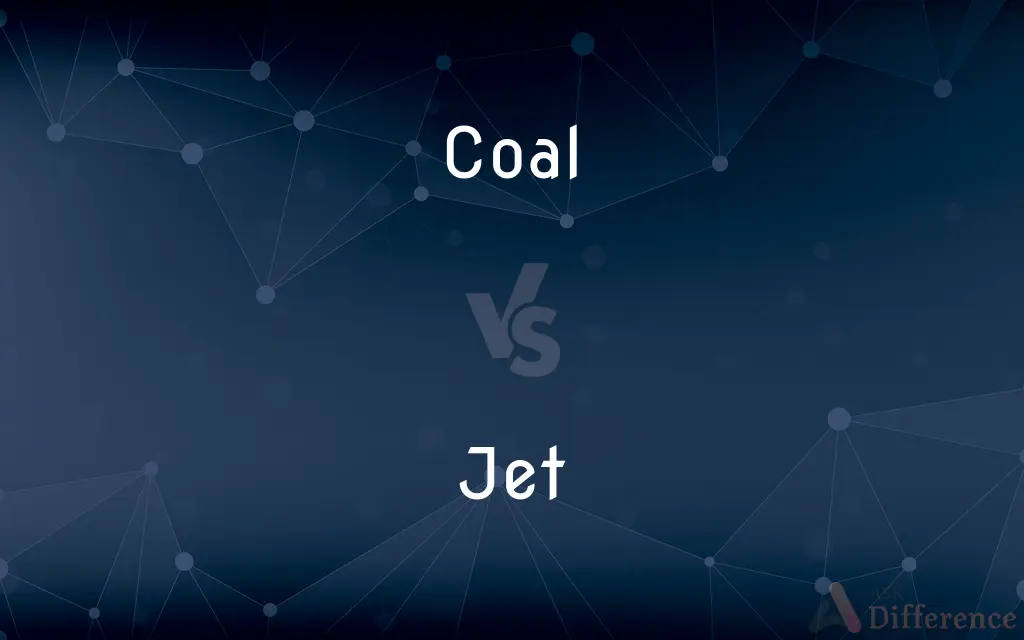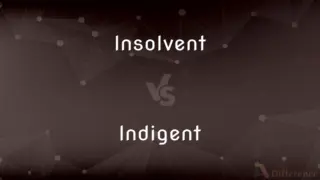Coal vs. Jet — What's the Difference?
By Maham Liaqat & Fiza Rafique — Updated on March 28, 2024
Coal is a sedimentary rock used primarily for energy, while jet is a gemstone formed from fossilized wood.

Difference Between Coal and Jet
Table of Contents
ADVERTISEMENT
Key Differences
Coal is a naturally occurring fossil fuel, formed over millions of years through the decomposition of plant material under high pressure and temperature. It is primarily used for electricity generation and as a fuel source in various industries. Jet, on the other hand, is a type of lignite, a precursor to coal, known for its deep black color and organic origin. It is not used as a fuel but rather as a gemstone, particularly popular during the Victorian era for mourning jewelry.
Coal is known for its high carbon content, which makes it a potent energy source but also a significant contributor to carbon dioxide emissions and environmental pollution. Jet is formed from the fossilization of wood under high pressure over millions of years, giving it a unique luster and making it lightweight compared to other gemstones.
While coal is mined primarily for its energy-producing capabilities, jet is valued for its aesthetic appeal and rarity in the gemstone market. The mining processes of both materials are significantly different, with coal mining being a large-scale industrial operation and jet mining often being more artisanal.
Coal's impact on the environment is significant, contributing to air pollution, greenhouse gas emissions, and landscape alteration. Jet, while also a product of mining, does not have the same level of environmental impact due to its use as a gemstone rather than a fuel source.
The cultural significance of coal and jet also diverges. Coal has been a cornerstone of industrialization and economic development, powering industries and households. Jet, however, holds historical and cultural significance, especially in jewelry, symbolizing mourning and remembrance in the 19th century.
ADVERTISEMENT
Comparison Chart
Composition
Carbon, various minerals
Fossilized wood, carbon
Primary Use
Energy production, industrial fuel
Gemstone, jewelry
Formation Process
Decomposition of plant material
Fossilization of wood
Environmental Impact
High, contributes to pollution
Lower, mainly due to extraction
Cultural Significance
Industrialization, energy
Mourning jewelry, Victorian era
Compare with Definitions
Coal
A black or dark brown rock consisting mainly of carbonized plant matter, found mainly in underground deposits.
Coal mining remains a significant industry in some regions of the world.
Jet
A hard, black, lustrous material used as a gemstone.
The necklace was made of jet, polished to a high shine.
Coal
Integral to the industrial revolution.
Coal-powered steam engines revolutionized transportation and manufacturing.
Jet
Formed from fossilized wood under extreme pressure.
Jet is a unique gemstone with an organic origin.
Coal
Used as a traditional source of fuel.
Many households once relied on coal for heating and cooking.
Jet
Carved into various shapes for jewelry.
Artisans carved the jet into intricate designs for brooches and earrings.
Coal
Associated with environmental concerns.
The burning of coal is a major source of carbon dioxide emissions.
Jet
Popular in Victorian mourning jewelry.
Victorian widows often wore jet jewelry as a sign of mourning.
Coal
Mined via surface or underground methods.
Surface mining is often employed when coal seams are close to the earth's surface.
Jet
Known for its lightweight and warm feel.
Unlike other stones, jet feels warm to the touch and is surprisingly light.
Coal
Coal is a combustible black or brownish-black sedimentary rock, formed as rock strata called coal seams. Coal is mostly carbon with variable amounts of other elements, chiefly hydrogen, sulfur, oxygen, and nitrogen.
Jet
A dense black coal that takes a high polish and is used for jewelry.
Coal
A combustible black or dark brown rock consisting chiefly of carbonized plant matter, found mainly in underground seams and used as fuel
A coal fire
Two bags of coal
Jet
A deep black.
Coal
Provide with a supply of coal
Ships had to be coaled and supplied
Jet
A high-velocity fluid stream forced under pressure out of a small-diameter opening or nozzle.
Coal
A natural dark brown to black graphitelike material used as a fuel, formed from fossilized plants and consisting of amorphous carbon with various organic and some inorganic compounds.
Jet
An outlet, such as a nozzle, used for emitting such a stream.
Coal
A piece of this substance.
Jet
Something emitted in or as if in a high-velocity fluid stream
"such myriad and such vivid jets of images" (Henry Roth).
Coal
A glowing or charred piece of solid fuel.
Jet
A jet-propelled vehicle, especially a jet-propelled aircraft.
Coal
Charcoal.
Jet
A jet engine.
Coal
To burn (a combustible solid) to a charcoal residue.
Jet
Made of or resembling a dense, black, highly polished coal.
Coal
To provide with coal.
Jet
Black as coal; jet-black
Jet hair.
Coal
To take on coal.
Jet
To travel by jet aircraft
Jetted from Houston to Los Angeles.
Coal
(uncountable) A black or brownish black rock formed from prehistoric plant remains, composed largely of carbon and burned as a fuel.
The coal in this region was prized by ironmasters in centuries past, who mined it in the spots where the drainage methods of the day permitted.
Jet
To move very quickly.
Coal
(countable) A type of coal, such as bituminous, anthracite, or lignite, and grades and varieties thereof, as a fuel commodity ready to buy and burn.
Put some coal on the fire.
Order some coal from the coalyard.
Jet
To propel outward or squirt, as under pressure
"Any man might ... hang around ... jetting tobacco juice" (Ross Lockridge, Jr.).
Coal
(countable) A piece of coal used for burning this use is less common in American English
Put some coals on the fire.
Jet
A collimated stream, spurt or flow of liquid or gas from a pressurized container, an engine, etc.
Coal
(countable) A glowing or charred piece of coal, wood, or other solid fuel.
Just as the camp-fire died down to just coals, with no flames to burn the marshmallows, someone dumped a whole load of wood on, so I gave up and went to bed.
Jet
A spout or nozzle for creating a jet of fluid.
Coal
Charcoal.
Jet
(aviation) A type of airplane using jet engines rather than propellers.
Coal
(intransitive) To take on a supply of coal (usually of steam ships).
Jet
An engine that propels a vehicle using a stream of fluid as propulsion.
Coal
(transitive) To supply with coal.
To coal a steamer
Jet
A turbine.
Coal
(intransitive) To be converted to charcoal.
Jet
A rocket engine.
Coal
(transitive) To burn to charcoal; to char.
Jet
A part of a carburetor that controls the amount of fuel mixed with the air.
Coal
(transitive) To mark or delineate with charcoal.
Jet
(physics) A narrow cone of hadrons and other particles produced by the hadronization of a quark or gluon.
Coal
A thoroughly charred, and extinguished or still ignited, fragment from wood or other combustible substance; charcoal.
Jet
(dated) Drift; scope; range, as of an argument.
Coal
A black, or brownish black, solid, combustible substance, dug from beds or veins in the earth to be used for fuel, and consisting, like charcoal, mainly of carbon, but more compact, and often affording, when heated, a large amount of volatile matter.
Jet
The sprue of a type, which is broken from it when the type is cold.
Coal
To burn to charcoal; to char.
Charcoal of roots, coaled into great pieces.
Jet
(mineral) A hard, black form of coal, sometimes used in jewellery.
Coal
To mark or delineate with charcoal.
Jet
(color) The colour of jet coal, deep grey.
Coal
To supply with coal; as, to coal a steamer.
Jet
(intransitive) To spray out of a container.
Coal
To take in coal; as, the steamer coaled at Southampton.
Jet
(transitive) To spray with liquid from a container.
Farmers may either dip or jet sheep with chemicals.
Coal
Fossil fuel consisting of carbonized vegetable matter deposited in the Carboniferous period
Jet
(intransitive) To travel on a jet aircraft or otherwise by jet propulsion
Coal
A hot glowing or smouldering fragment of wood or coal left from a fire
Jet
(intransitive) To move (running, walking etc.) rapidly around
Coal
Burn to charcoal;
Without a drenching rain, the forest fire will char everything
Jet
To shoot forward or out; to project; to jut out.
Coal
Supply with coal
Jet
To strut; to walk with a lofty or haughty gait; to be insolent; to obtrude.
Coal
Take in coal;
The big ship coaled
Jet
To jerk; to jolt; to be shaken.
Jet
To adjust the fuel to air ratio of a carburetor; to install or adjust a carburetor jet
Jet
To leave; depart.
Gotta jet. See you tomorrow.
Jet
Propelled by turbine engines.
Jet airplane
Jet
Very dark black in colour.
Jet
Same as 2d Get.
Jet
A variety of lignite, of a very compact texture and velvet black color, susceptible of a good polish, and often wrought into mourning jewelry, toys, buttons, etc. Formerly called also black amber.
Jet
A shooting forth; a spouting; a spurt; a sudden rush or gush, as of water from a pipe, or of flame from an orifice; also, that which issues in a jet.
Jet
Drift; scope; range, as of an argument.
Jet
The sprue of a type, which is broken from it when the type is cold.
Jet
To strut; to walk with a lofty or haughty gait; to be insolent; to obtrude.
He jets under his advanced plumes!
To jet upon a prince's right.
Jet
To jerk; to jolt; to be shaken.
Jet
To shoot forward or out; to project; to jut out.
Jet
To spout; to emit in a stream or jet.
A dozen angry models jetted steam.
Jet
An airplane powered by one or more jet engines
Jet
The occurrence of a sudden discharge (as of liquid)
Jet
A hard black form of lignite that takes a brilliant polish and is used in jewellery or ornamentation
Jet
Street names for ketamine
Jet
An artificially produced flow of water
Jet
Issue in a jet; come out in a jet; stream or spring forth;
Water jetted forth
Flames were jetting out of the building
Jet
Fly a jet plane
Jet
Of the blackest black; similar to the color of jet or coal
Common Curiosities
What are the environmental impacts of coal?
Coal mining and combustion contribute to air pollution, greenhouse gas emissions, and landscape degradation.
What is coal used for?
Coal is primarily used for electricity generation and as an industrial fuel.
Can coal be used in jewelry?
Coal is not typically used in jewelry due to its softness and lack of luster compared to gemstones like jet.
Can jet be found in all coal mines?
Jet is not typically found in coal mines, as it forms from specific types of fossilized wood under different conditions.
How do the mining processes for coal and jet differ?
Coal mining is a large-scale industrial operation, while jet mining is often more artisanal and focused on gemstone extraction.
How does the use of coal impact climate change?
The burning of coal for energy produces large amounts of carbon dioxide, a greenhouse gas that contributes to climate change.
Can both coal and jet be found worldwide?
Coal deposits are found worldwide, while jet is more rare and located in specific geographic locations.
How is jet formed?
Jet is formed from the fossilization of wood under high pressure over millions of years.
Is jet a type of coal?
Jet is a precursor to coal, known as lignite, and is considered a gemstone rather than a fuel source.
Was jet only popular in the Victorian era?
While jet was particularly popular in the Victorian era for mourning jewelry, it has been used throughout history and is still used in jewelry today.
What makes jet a desirable material for jewelry?
Its deep black color, luster, and organic origin make jet desirable for jewelry, particularly as a symbol of mourning.
Why is coal considered a non-renewable resource?
Coal is considered non-renewable because it forms over millions of years and cannot be replaced at the rate it is consumed.
Are there any alternatives to coal for energy production?
Yes, alternatives include renewable energy sources like solar, wind, and hydroelectric power.
Is jet more valuable than coal?
As a gemstone, jet can be more valuable than coal, especially in terms of cultural and historical significance.
Can jet be synthetically produced?
While synthetic imitations exist, authentic jet is valued for its natural origin and cannot be synthetically produced with the same properties.
Share Your Discovery

Previous Comparison
Insolvent vs. Indigent
Next Comparison
Read vs. ReciteAuthor Spotlight
Written by
Maham LiaqatCo-written by
Fiza RafiqueFiza Rafique is a skilled content writer at AskDifference.com, where she meticulously refines and enhances written pieces. Drawing from her vast editorial expertise, Fiza ensures clarity, accuracy, and precision in every article. Passionate about language, she continually seeks to elevate the quality of content for readers worldwide.














































